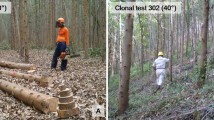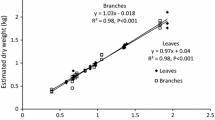Abstract
Eucalyptus camaldulensis Dehnh. and E. globulus Labill. are economically important species for wood and pulpwood materials. Representative heights for assessing whole-tree values of cell-type proportions (vessels, fibers, ray and axial parenchyma percentages) using increment cores were examined by analysis of within-tree variations. Pattern differences were evaluated between trees and species in both radial and axial directions by statistical data analysis (Moses test). In E. camaldulensis, within-tree variation of vessel percentage was generally higher in the upper and outer regions of the trunk. In contrast, E. globulus within-tree variation was unclear. In both species, although no clear pattern of fiber percentages was observed, within-tree variations of ray and axial parenchyma levels were higher in the lower and inner regions. Significant differences in patterns were observed in the axial variation between species for vessel percentages and in the radial variation between trees of E. camaldulensis for ray parenchyma percentages. The representative heights for assessing whole-tree cell-type proportions were 0.8 m above the ground for E. camaldulensis and 2.8 m for E. globulus, regardless of differences in tree height and pattern of within-tree variation of cell-type proportions.









Similar content being viewed by others
Notes
Kappa number is an indication of the residual lignin content or bleachability of wood pulp by a standardized analysis method and estimates the amount of chemicals required during bleaching, being this amount related to the lignin content of the pulp (Tarrés et al. 2017).
Vessel picking is a problem for pulp and paper production of hardwood. Vessel elements are picked from the surface of paper during the printing process and deposited on the printing surface, causing ink-free spots on the printed page (Hudson et al. 1998).
References
Albaugh JM, Dye PJ, King JS (2013) Eucalyptus and water use in South Africa. Int J For Res 2013:1–11. https://doi.org/10.1155/2013/852540
Alves ES, Longui EL, Amano E (2008) Pernambuco wood (Caesalpinia echinata) used in the manufacture of bows for string instruments. IAWA J 29(3):323–335. https://doi.org/10.1163/22941932-90000190
Amidon TE (1981) Effect of the wood properties of hardwoods on kraft paper properties. Tappi 64(3):123–126
Bendtsen BA (1978) Properties of wood from improved and intensively managed trees. For Prod J 28(10):61–72
Chowdhury MQ, Ishiguri F, Hiraiwa T, Matsumoto K, Takashima Y, Iizuka K, Yokota S, Yoshizawa N (2012) Variation in anatomical properties and correlations with wood density and compressive strength in Casuarina equisetifolia growing in Bangladesh. Aust For 75(2):95–99. https://doi.org/10.1080/00049158.2012.10676390
Colley J (1973) The influence of vessel elements on the picking tendency of eucalypt pulps. Paper Technol 14(5):293–296
Colley J, Ward J (1976) Studies on the vessel picking tendency of Eucalyptus deglupta kraft pulp. Appita 29(5):344–348
Denne MP, Hale MD (1999) Cell wall and lumen percentages in relation to wood density of Nothofagus nervosa. IAWA J 20(1):23–36. https://doi.org/10.1163/22941932-90001544
Downes G, Hudson I, Raymond C, Dean G, Michell T, Schimleck L, Evans R, Muneri A (1997) Sampling plantation eucalypts for wood and fibre properties. CSIRO Publications, Melbourne, p 144
Henry RJ (2014) Genetics, genomics and breeding of eucalypts. CRC Press, Boca Raton, p 205
Hillis WE (1978) Wood quality and utilization. In: Hillis WE, Brown AG (eds) Eucalyptus for wood production. CSIRO Publications, Melbourne, pp 259–289
Hillis WE (1990) Fast growing eucalypts and some of their characteristics. In: Werner D, Muller P (eds) Fast growing trees and nitrogen fixing trees. Gustav Fischer Verlag, Stuttgart, pp 184–193
Hudson I, Wilson L, Van Beveren K (1998) Vessel and fibre property in Eucalyptus globulus and Eucalyptus nitens: some preliminary results. IAWA J 19(2):111–130. https://doi.org/10.1163/22941932-90001514
Hudson I, Wilson L, Van Beveren K (2001) Between species differences in whole tree maps of fibre properties in E. nitens and E. globulus—utility of control deviation charts to assess optimal sampling height. Appita J 54(2):182–189
Igartua DV, Monteoliva SE, Monterubbianesi MG, Villegas MS (2003) Basic density and fibre length at breast height of Eucalyptus globulus ssp. globulus for parameter prediction of the whole tree. IAWA J 24(2):173–184. https://doi.org/10.1163/22941932-90000330
Ismail J, Jusoh MZ, Sahri MH (1995) Anatomical variation in planted kelempayan (Neolamarckia cadamba, Rubiaceae). IAWA J 16(3):227–287. https://doi.org/10.1163/22941932-90001411
Jorge F, Quilhó T, Pereira H (2000) Variations of fibre length in wood and bark in Eucalyptus globulus. IAWA J 21(1):41–48. https://doi.org/10.1163/22941932-90000235
Leal S, Pereira H, Grabner M, Wimmer R (2003) Clonal and site variation of vessels in 7-year-old Eucalyptus globulus. IAWA J 24(2):185–195. https://doi.org/10.1163/22941932-90000331
Malan FS (1988) Genetic variation in some growth and wood properties among 18 full-sib families of South African grown Eucalyptus grandis: a preliminary investigation. S Afr For J 146(1):38–43. https://doi.org/10.1080/00382167.1988.9630357
Malan FS (1991) Variation, association and inheritance of juvenile wood properties of Eucalyptus grandis Hill ex Maiden with special reference to the effect of rate of growth. S Afr For J 157(1):16–23. https://doi.org/10.1080/00382167.1991.9629094
Malan FS, Gerischer GFR (1987) Wood property differences in South African grown Eucalyptus grandis trees of different growth stress intensity. Holzforschung 41(6):331–335. https://doi.org/10.1515/hfsg.1987.41.6.331
Malan FS, Hoon M (1992) Effect of initial spacing and thinning on some wood properties of Eucalyptus grandis. S Afr For J 163(1):13–20. https://doi.org/10.1080/00382167.1992.9629362
Malan FS, Male JR, Venter JSM (1994) Relationship between the properties of eucalyptus wood and some chemical, pulp and paper properties. Pap S Afr 2:6–16
McKenzie HM, Shelbourne CJA, Kimberley MO, McKinley RS, Britton RAJ (2003) Processing young plantation-grown Eucalyptus nitens for solid-wood products. 2: Predicting product quality from tree, increment core, disc, and 1-m billet properties. NZ J For Sci 33(1):79–113
Moses LE (1952) A two-sample test. Psychometrika 17(3):239–247. https://doi.org/10.1007/BF02288755
Muneri A, Asada T, Tomita K, Kusunoki K, Szota C (2011) Between-tree variation in stem volume, wood density, fibre length and kraft pul** properties of’ Eucalyptus globulus and the utility of field-portable NIR spectroscopy and wood cores in evaluating pulpwood quality properties of standing trees. Appita J 64(4):356
Myburg AA, Grattapaglia D, Tuskan GA, Hellsten U, Hayes RD, Grimwood J et al (2014) The genome of Eucalyptus grandis. Nature 510:356–362. https://doi.org/10.1038/nature13308
Nicholls JWP, Phillips FH (1970) Preliminary study of coppice-grown Eucalyptus viminalis as a source chip materials. Technical papers. No. 58, Division of Forest Products, CSIRO, Melbourne, Australia
Nolan G, Washusen R, Jennings S, Greaves B, Parsons M (2005) Eucalypt plantations for solid wood products in Australia—a review. Project no. PN04.3002, Forest and Wood Products Research and Development Corporation, Melbourne, Australia
Ogata Y (1978) Studies of vessel elements on Eucalyptus woods. Part 2. Sheetforming studies and chemical analysis of Eucalyptus vessel elements. Jpn Tappi 32(6):377–386
Ohshima J, Yokota S, Yoshizawa N, Ona T (2004) Within-tree variation of vessel morphology and frequency and representative heights for estimating the whole-tree value in Eucalyptus camaldulensis and E. globulus. Appita J 57(1):64–69
Ohshima J, Yokota S, Yoshizawa N, Ona T (2005a) Examination of within-tree variations and the heights representing whole-tree values of derived wood properties for quasi-non-destructive breeding of Eucalyptus camaldulensis and Eucalyptus globulus as quality pulpwood. J Wood Sci 51(2):102–111. https://doi.org/10.1007/s10086-004-0625-3
Ohshima J, Yokota S, Yoshizawa N, Ona T (2005b) Representative heights for assessing whole-tree values and the within-tree variations of derived wood properties in Eucalyptus camaldulensis and E. globulus. Wood Fiber Sci 37(1):51–65. https://doi.org/10.1007/s10086-004-0625-3
Ona T, Sonoda T, Ito K, Shibata M, Tamai Y, Kojima Y (1996) Use of the radially divided increment core method to assess pulpwood quality for eucalypt breeding in E. camaldulensis and E. globulus. Appita J 49(5):325–331
Ona T, Sonoda T, Ito K, Shibata M, Tamai Y, Kojima Y, Ohshima J, Yokota S, Yoshizawa N (2001) Investigation of relationships between cell and pulp properties in Eucalyptus by examination of within-tree variations. Wood Sci Technol 35(3):229–243. https://doi.org/10.1007/s002260100090
Palermo GDM, Latorraca JDF, de Carvalho AM, Calonego FW, Severo ETD (2015) Anatomical properties of Eucalyptus grandis wood and transition age between the juvenile and mature woods. Eur J Wood Prod 73(6):775–780. https://doi.org/10.1007/s00107-015-0947-4
Pirralho M, Flores D, Sousa VB, Quilhó T, Knapic S, Pereira H (2014) Evaluation on paper making potential of nine Eucalyptus species based on wood anatomical features. Ind Crop Prod 54:327–334. https://doi.org/10.1016/j.indcrop.2014.01.040
R Core Team (2014) R: a language and environment for statistical computing. R Foundation for Statistical Computing, Vienna, Austria. http://www.R-project.org/. Accessed 5 Jan 2015
Ramírez M, Rodríguez J, Peredo M, Valenzuela S, Mendonça R (2009) Wood anatomy and biometric parameters variation of Eucalyptus globulus clones. Wood Sci Technol 43(1):131–141. https://doi.org/10.1007/s00226-008-0206-5
Rao RV, Shashikala S, Sreevani P, Kothiyal V, Sarma CR, Lal P (2002) Within tree variation in anatomical properties of some clones of Eucalyptus tereticornis Sm. Wood Sci Technol 36(3):271–285. https://doi.org/10.1007/s00226-002-0139-3
Raymond CA (2002) Genetics of Eucalyptus wood properties. Ann For Sci 59(5–6):525–531. https://doi.org/10.1051/forest:2002037
Raymond CA, Schimleck LR, Muneri A, Michell AJ (2001) Nondestructive sampling of Eucalyptus globulus and E. nitens for wood properties. III. Predicted pulp yield using near infrared reflectance analysis. Wood Sci Technol 35(3):203–215. https://doi.org/10.1007/s002260100092
Sardinha RMA, Hughes JF (1979) Wood properties variation of Eucalyptus saligna Sm. from Angola. Anais doinstituto Superior de Agronomia, Univ. Tecnica de Lisboa 37:81–101
Sato S (2007) Breeding strategy for the pulp quality improvement in Eucalyptus trees. Jpn Tappi J 61(1):79–83
Schimleck LR, Rezende GD, Demuner BJ, Downes GM (2006) Estimation of whole-tree wood quality traits using near infrared spectra from increment cores. Appita J 59(3):231–236
Tarrés Q, Pellicer N, Balea A, Merayo N, Negro C, Blanco A, Delgado-Aguilar M, Mutjé P (2017) Lignocellulosic micro/nanofibers from wood sawdust applied to recycled fibers for the production of paper bags. Int J Biol Macromol 105:664–670. https://doi.org/10.1016/j.ijbiomac.2017.07.092
Taylor FW (1973a) Anatomical wood properties of South African grown Eucalyptus grandis. S Afr For J 84:20–24. https://doi.org/10.1080/00382167.1973.9629286
Taylor FW (1973b) Variations in the anatomical properties of South African grown Eucalyptus grandis. Appita 27(3):171–178
Taylor FW, Wooten TE (1973) Wood property variation of Mississippi delta hardwoods. Wood Fiber Sci 5(1):2–13
Uetimane E Jr, Ali AC (2011) Relationship between mechanical properties and selected anatomical features of ntholo (Pseudolachnostylis maprounaefolia). J Trop For Sci 23(2):166–176
Vurdu H, Bensend DW (1980) Proportions and types of cells in stems, banches, and roots of European black alder (Alnus glutinosa L. Gaertn.). Wood Sci 13(1):36–40
Washusen R (2011) Processing plantation grown Eucalyptus globulus and Eucalyptus nitens for solid wood products—is it viable? Technical report no. 209, Cooperative Research Centre for Forestry, Hobart, Australia
Wu YQ, Hayashi K, Liu Y, Cai Y, Sugimori M (2006) Relationships of anatomical characteristics versus shrinkage and collapse properties in plantation-grown eucalypt wood from China. J Wood Sci 52(3):187–194. https://doi.org/10.1007/s10086-005-0751-6
Zhang SY, Zhong Y (1992) Structure–property relationship of wood in East-Liaoning oak. Wood Sci Technol 26(2):139–149. https://doi.org/10.1007/BF00194469
Zobel BJ, van Buijtenen JP (1989) Wood variation: its causes and control. Springer, Berlin, p 363
Acknowledgements
The authors appreciate the Department of Conservation and Land Management (Western Australia) for sample supplements and Mr. K. Adachi, Faculty of Agriculture, Utsunomiya University, Japan, for his assistance with measurements.
Author information
Authors and Affiliations
Corresponding author
Additional information
Project funding: This research was partly supported by the CREST program of JST (Japan Science and Technology) and the Oji Paper Company, Japan.
The online version is available at http://www.springerlink.com
Corresponding editor: Yu Lei.
Rights and permissions
About this article
Cite this article
Ohshima, J., Iizuka, K., Ishiguri, F. et al. Representative heights for assessing whole-tree values of cell-type proportions in Eucalyptus camaldulensis and E. globulus. J. For. Res. 31, 885–900 (2020). https://doi.org/10.1007/s11676-018-00871-z
Received:
Accepted:
Published:
Issue Date:
DOI: https://doi.org/10.1007/s11676-018-00871-z




